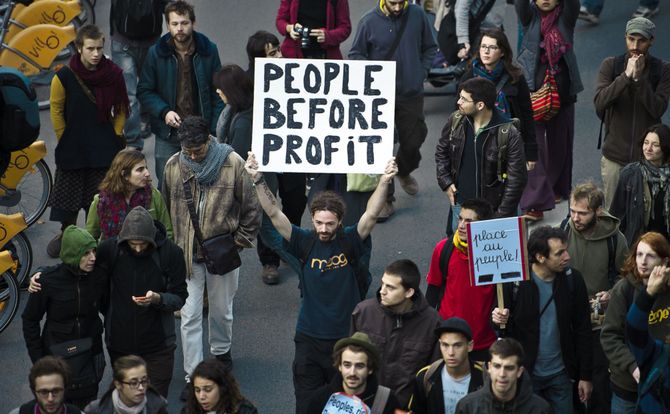Millennials and democratic socialism
Millennials are increasingly supporting socialism as a remedy for today’s political and economic ills. 30 years after the fall of the Berlin Wall, some might be surprised. A lack of academic rigor, cultural shifts and economic trends may all have contributed to the trend. So far, socialism has always ended in failure.

In a nutshell
- Throughout the West, youth increasingly support “democratic socialism”
- Cultural and economic shifts are fueling this sentiment
- Whenever socialism gains popularity, the trend follows a certain pattern
- Socialism has always ended in failure; some think it might be different this time
Poll after poll shows socialist ideas are gaining ground among millennials – the generation of people born roughly between the early 1980s and early 2000s. In the United States, membership of the Democratic Socialists of America party is increasing, while self-proclaimed democratic socialist Congresswoman Alexandria Ocasio-Cortez has become something of a rock star.
In France’s 2017 presidential election, half of young people voted for candidates from the two quasi-socialist parties: Marine Le Pen’s National Rally on the right and Jean-Luc Melenchon’s France Insoumise on the left. That same year, the United Kingdom’s Labour Party, led by democratic socialist Jeremy Corbyn, benefited from the highest youth turnout in 25 years to gain 30 seats in the British Parliament. In Spain, the left-wing Podemos party’s activism appeals to a lot of young people.
Thirty years after the fall of the Berlin Wall, it is clear that socialism is enjoying a comeback among the youth. Why? And what is the future of the movement?
Great recessions
Socialism’s resurgence among young people may be due to fading memories of its tragic outcomes in the 20th century: in the Soviet Union, North Korea, Ethiopia, Cuba and Romania, just to name a few. The Cold War reminded people in the West that they were lucky to be living in the Free World. Yet many left-leaning teachers and intellectuals downplay the hard reality of socialism. Even though historians have plenty of access to records now that the Iron Curtain has fallen, education systems only give a mild, if not romanticized, account of the brutality in socialist societies. Many millennials are therefore ignorant of socialism’s realities.
Sluggish economic growth and high youth unemployment explain millennials’ frustration with market economics.
By the same token, they have grown up with the Great Recession. Sluggish economic growth and high youth unemployment in places like Spain, Italy and France explain their frustration with market economics. Moreover, bankers’ ability to avoid responsibility for the 2008 financial meltdown makes it easy to blame “capitalism” for economic woes. But here again, knowledge matters: textbook and media analyses mostly describe the subprime crisis as a failure of the capitalist system and its “greedy” banks, while avoiding the role of governments and central banks in offering skewed incentives through housing or monetary policy. Like in the 1930s, government, with more regulation and socialist-inspired policies, is seen as a savior, not a culprit.
The 99 percent
Low-interest-rate monetary policies may have also had an impact on how millennials see capitalism. There are two main reasons for this. First, the notion of savings is central to capitalism and its spirit of delayed gratification and patient effort. Such policies have drastically reduced the incentive to save. Second, they have convinced people that with a wave of their magic policy wand, central bankers can break economic laws that once were considered cast in stone. The sentiment that “debt does not matter” is an example of this misguided perception. Socialism, after all, refutes traditional economics.
In the U.S., the Occupy Wall Street movement played a big role in consolidating socialist momentum (notably behind the Democratic Socialists of America). Later, the work of Thomas Piketty (whose analysis had significant faults) on the rise of rentier capitalism and the associated social inequality, gave the Occupy Wall Street-inspired youth more arguments. It was no longer workers against capitalist bosses, but the poor and middle class, the “99 percent,” against the “1 percent.” Socialism had found a new class struggle.
Cultural shifts
The trend also has roots in the past. The values introduced by the counterculture of the late 1960s were a rejection not only of authority, but also of personal discipline and self-control. Instead, they promoted the right to enjoy without constraint – “free love,” as it were. Popular with young people and constantly reinvented, such movements spurn traditional bourgeois capitalist ethics and meld well with the idea of a socialist society as “cool.” No mention is made of other socialist phenomena, like the endless queues, the Soviet Union’s use of Stakhanovism to increase productivity without rewarding workers or China’s laogai penal labor system.

Christianity has an anti-communist tradition, and some see its weakening in the West as another cause of the trend. Maybe socialism simply fills the void left by the decline of religion, which provides a sense of togetherness. The erosion of the family – both the extended and traditional nuclear family – along with more intense urbanization, also creates a greater need for community. The phenomenon reflects the role socialism played in response to the huge social shifts brought on by the Industrial Revolution. Economists like the late James M. Buchanan would see the trend partly explained by “parentalism” – the demand for a nanny state. Welfare states tend to increase people’s demand for social safety. Socialism is the next step.
Safe distance
When defenders of the socialist system know its abysmal record in human rights and prosperity, they differentiate between “bad” and “good” socialism. After all, teenagers in the 2000s wore T-shirts with Che Guevara’s portrait, not with Stalin’s. (Here again though, ignorance of this “good” socialist’s deeds can be depressing, even making allowances for the violence of the regimes he opposed.) Many go farther: to them Soviet-style, authoritarian socialism was not “real” socialism. “Real” socialism, they say, has not yet been tried.
Inspired by the works of French philosopher Jean-Francois Revel, Dr. Kristian Niemetz of the Institute of Economic Affairs in London argues in his recent book, Socialism: The Failed Idea That Never Dies, that virtually all socialist experiments follow a pattern. They start with praise from fans around the world who see a new model of solidarity and liberation from the profit motive. When the first cracks in the system appear, the supporters offer excuses (for example, that it has been sabotaged). Finally, when the experiment fails miserably, adherents argue that the system was not “real” socialism, because it was authoritarian. Venezuela is just the latest example of this cycle.
Demand for democracy
An important aspect of the movement is its claim to be genuinely democratic, with bottom-up, participatory, deliberative procedures to collective decision-making. Modern democracy has certainly disappointed its citizens, both because politicians tend to break their election promises and because bureaucrats are gaining power. This type of democracy is turning into a game played by an unaccountable elite that excludes ordinary people. In France, one of the central demands of the Yellow Vest movement (which perplexingly went from an anti-tax campaign to one advocating bigger government and higher taxes) was to allow for citizen-initiated referendums. The idea is to give the people more democratic choice.
In the market of political ideas, socialism has been newly branded as democratic.
While socialism was not explicitly advocated in the Yellow Vest movement, more democracy was. And in the market of political ideas, socialism has been newly branded as democratic. Hence the epithet “democratic socialism.” But has anything changed? Interestingly, socialist experiments usually start with a claim to being more democratic. Even as late as the 1930s, socialist intellectuals such as Sydney Webb portrayed the Soviet Union as a democratic experiment. Stalin was seen as a mere party functionary, not an autocrat. In the early 1920s, Stalin himself criticized Trotsky for his “coercive” strategy to impose socialism. Instead, Stalin said, he favored using “persuasion.”
It is important to note that the socialism being advocated is more radical than the traditional European social democracy, which amounts to a market economy plus a big welfare and regulatory state, like in Germany or the Nordic countries. Confusingly, Ms. Ocasio-Cortez sometimes likens her “democratic socialism” to this model. But make no mistake: democratic socialism aims to increase the degree of public ownership in the economy, with self-management and decentralized, socialist planning.
Different this time?
Could democratic socialism in the millennial age be different? True, if socialism were to suddenly turn authoritarian, it would be difficult to extinguish today’s sense of personal freedom or force people to relinquish their higher standards of living. Some thinkers therefore dismiss the idea that this new socialism could bring about a return to gulags and organized famines. They might be right.
Nonetheless, socialist constituencies will increasingly push politicians toward bigger government. With current levels of debt and public spending, increasing the size of government would be unwise.
Why should popular wishes be turned into law if they would obviously infringe on freedoms or are simply pipe dreams?
And what if radical democratic socialist policies were implemented? Would participatory democracy work this time? Political transaction costs would be too high, especially given the explosion in services that require regulation and would therefore need to be “deliberated upon.” However, referenda are useful, and legislating could be decentralized to offer more institutional flexibility and diversity. Switzerland is a good example – and its system is far from socialist. Civil society already allows people to participate in “common” projects, especially with today’s world of social networks.
Moreover, why should popular wishes be turned into law if they infringe on freedoms or are simply pipe dreams? (In practice, socialist systems stop listening to popular wishes quite quickly, anyway.) The problem of the tyranny of the majority remains, as does the issue of certain members of society gaining too much power by claiming to speak for the people. How can respect for the rule of law be guaranteed? The lesson from George Orwell’s Animal Farm that the tyranny of the majority inevitably becomes a tyranny of a minority rings true.
Then there is the question of the economics. While the model of self-managed workers’ cooperatives may be laudable – and in fact frequently practiced within markets – imposing it onto the entire economy would end in failure. Such organization presupposes horizontal governance structures that are only found in trades with a limited number of workers or with a relatively homogenous mix of workers, to avoid the need for hierarchy. Removing the profit motive and abolishing the price system would make economic coordination under democratic socialism dysfunctional – just as it was in the Soviet Union.







